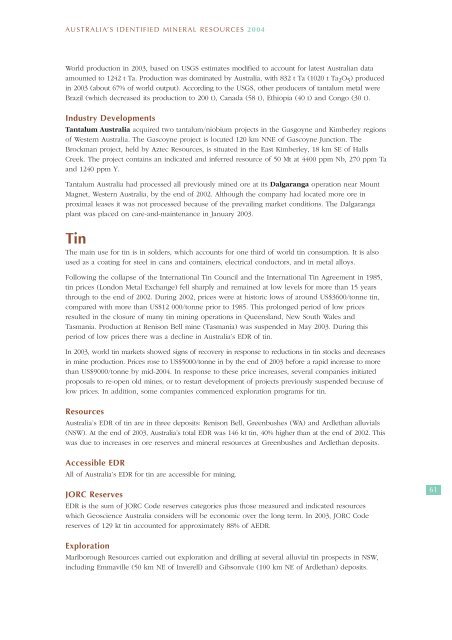australia's identified mineral resources 2004 - Geoscience Australia
australia's identified mineral resources 2004 - Geoscience Australia
australia's identified mineral resources 2004 - Geoscience Australia
You also want an ePaper? Increase the reach of your titles
YUMPU automatically turns print PDFs into web optimized ePapers that Google loves.
AUSTRALIA’S IDENTIFIED MINERAL RESOURCES <strong>2004</strong><br />
World production in 2003, based on USGS estimates modified to account for latest <strong>Australia</strong>n data<br />
amounted to 1242 t Ta. Production was dominated by <strong>Australia</strong>, with 832 t Ta (1020 t Ta 2 O 5 ) produced<br />
in 2003 (about 67% of world output). According to the USGS, other producers of tantalum metal were<br />
Brazil (which decreased its production to 200 t), Canada (58 t), Ethiopia (40 t) and Congo (30 t).<br />
Industry Developments<br />
Tantalum <strong>Australia</strong> acquired two tantalum/niobium projects in the Gasgoyne and Kimberley regions<br />
of Western <strong>Australia</strong>. The Gascoyne project is located 120 km NNE of Gascoyne Junction. The<br />
Brockman project, held by Aztec Resources, is situated in the East Kimberley, 18 km SE of Halls<br />
Creek. The project contains an indicated and inferred resource of 50 Mt at 4400 ppm Nb, 270 ppm Ta<br />
and 1240 ppm Y.<br />
Tantalum <strong>Australia</strong> had processed all previously mined ore at its Dalgaranga operation near Mount<br />
Magnet, Western <strong>Australia</strong>, by the end of 2002. Although the company had located more ore in<br />
proximal leases it was not processed because of the prevailing market conditions. The Dalgaranga<br />
plant was placed on care-and-maintenance in January 2003.<br />
Tin<br />
The main use for tin is in solders, which accounts for one third of world tin consumption. It is also<br />
used as a coating for steel in cans and containers, electrical conductors, and in metal alloys.<br />
Following the collapse of the International Tin Council and the International Tin Agreement in 1985,<br />
tin prices (London Metal Exchange) fell sharply and remained at low levels for more than 15 years<br />
through to the end of 2002. During 2002, prices were at historic lows of around US$3600/tonne tin,<br />
compared with more than US$12 000/tonne prior to 1985. This prolonged period of low prices<br />
resulted in the closure of many tin mining operations in Queensland, New South Wales and<br />
Tasmania. Production at Renison Bell mine (Tasmania) was suspended in May 2003. During this<br />
period of low prices there was a decline in <strong>Australia</strong>’s EDR of tin.<br />
In 2003, world tin markets showed signs of recovery in response to reductions in tin stocks and decreases<br />
in mine production. Prices rose to US$5000/tonne in by the end of 2003 before a rapid increase to more<br />
than US$9000/tonne by mid-<strong>2004</strong>. In response to these price increases, several companies initiated<br />
proposals to re-open old mines, or to restart development of projects previously suspended because of<br />
low prices. In addition, some companies commenced exploration programs for tin.<br />
Resources<br />
<strong>Australia</strong>’s EDR of tin are in three deposits: Renison Bell, Greenbushes (WA) and Ardlethan alluvials<br />
(NSW). At the end of 2003, <strong>Australia</strong>’s total EDR was 146 kt tin, 40% higher than at the end of 2002. This<br />
was due to increases in ore reserves and <strong>mineral</strong> <strong>resources</strong> at Greenbushes and Ardlethan deposits.<br />
Accessible EDR<br />
All of <strong>Australia</strong>’s EDR for tin are accessible for mining.<br />
JORC Reserves<br />
EDR is the sum of JORC Code reserves categories plus those measured and indicated <strong>resources</strong><br />
which <strong>Geoscience</strong> <strong>Australia</strong> considers will be economic over the long term. In 2003, JORC Code<br />
reserves of 129 kt tin accounted for approximately 88% of AEDR.<br />
61<br />
Exploration<br />
Marlborough Resources carried out exploration and drilling at several alluvial tin prospects in NSW,<br />
including Emmaville (50 km NE of Inverell) and Gibsonvale (100 km NE of Ardlethan) deposits.

















